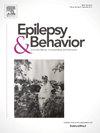Genetic association between epilepsy and gliomas: Insights from Mendelian randomization and single-cell transcriptomic analyses
IF 2.3
3区 医学
Q2 BEHAVIORAL SCIENCES
引用次数: 0
Abstract
Background
Seizures are prevalent in glioma patients, especially in those with low-grade gliomas. The interaction between gliomas and epilepsy involves complex biological mechanisms that are not fully understood.
Methods
We collected Genome-Wide Association Study data for epilepsy and gliomas, performed differential expression analysis, and conducted Gene Ontology (GO) enrichment analysis on the identified genes. Single-cell RNA sequencing data (scRNA-seq) from GSE221534 dataset in Gene Expression Omnibus (GEO) were used to analyze cell–cell interactions within glioma samples from patients with and without epilepsy.
Results
Mendelian Randomization (MR) analysis revealed significant associations between genetic variants related to epilepsy and glioma risk, suggesting a potential causal relationship, especially in astrocytomas. Differential expression analysis identified epilepsy-related genes that were significantly upregulated in astrocytoma tissues compared to normal brain tissues. GO enrichment analysis indicated that these genes are involved in critical biological processes such as neurogenesis and cellular signaling. The scRNA-seq analysis showed, compared to non-epileptic samples, glioma stem cells, microglia, and NK cells are increased in the core regions of astrocytomas in epileptic patients. Additionally, intercellular communication between tumor cells and other non-tumor cells is markedly enhanced in astrocytoma samples from epileptic patients.
Conclusion
This study provides evidence of a genetic association between epilepsy and gliomas and elucidates the biological mechanisms through which epilepsy may influence glioma progression.
癫痫与胶质瘤之间的遗传关联:孟德尔随机化和单细胞转录组分析的启示。
背景:癫痫发作在胶质瘤患者中非常普遍,尤其是在低级别胶质瘤患者中。胶质瘤与癫痫之间的相互作用涉及复杂的生物学机制,目前尚未完全明了:我们收集了癫痫和胶质瘤的全基因组关联研究数据,进行了差异表达分析,并对确定的基因进行了基因本体(GO)富集分析。基因表达总库(GEO)中GSE221534数据集的单细胞RNA测序数据(scRNA-seq)被用来分析癫痫患者和非癫痫患者胶质瘤样本中的细胞间相互作用:孟德尔随机化(MR)分析显示,癫痫相关基因变异与胶质瘤风险之间存在显著关联,这表明两者之间存在潜在的因果关系,尤其是在星形细胞瘤中。差异表达分析发现,与正常脑组织相比,癫痫相关基因在星形细胞瘤组织中明显上调。GO富集分析表明,这些基因参与了神经发生和细胞信号传导等关键生物过程。scRNA-seq分析表明,与非癫痫样本相比,癫痫患者星形细胞瘤核心区域的胶质瘤干细胞、小胶质细胞和NK细胞增多。此外,在癫痫患者的星形细胞瘤样本中,肿瘤细胞与其他非肿瘤细胞之间的细胞间通讯明显增强:这项研究为癫痫与胶质瘤之间的遗传关联提供了证据,并阐明了癫痫可能影响胶质瘤进展的生物学机制。
本文章由计算机程序翻译,如有差异,请以英文原文为准。
求助全文
约1分钟内获得全文
求助全文
来源期刊

Epilepsy & Behavior
医学-行为科学
CiteScore
5.40
自引率
15.40%
发文量
385
审稿时长
43 days
期刊介绍:
Epilepsy & Behavior is the fastest-growing international journal uniquely devoted to the rapid dissemination of the most current information available on the behavioral aspects of seizures and epilepsy.
Epilepsy & Behavior presents original peer-reviewed articles based on laboratory and clinical research. Topics are drawn from a variety of fields, including clinical neurology, neurosurgery, neuropsychiatry, neuropsychology, neurophysiology, neuropharmacology, and neuroimaging.
From September 2012 Epilepsy & Behavior stopped accepting Case Reports for publication in the journal. From this date authors who submit to Epilepsy & Behavior will be offered a transfer or asked to resubmit their Case Reports to its new sister journal, Epilepsy & Behavior Case Reports.
 求助内容:
求助内容: 应助结果提醒方式:
应助结果提醒方式:


